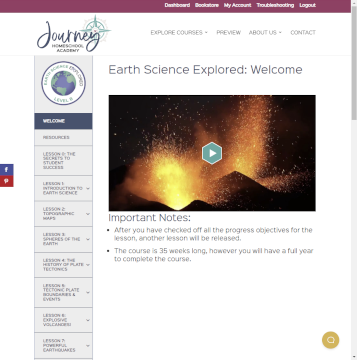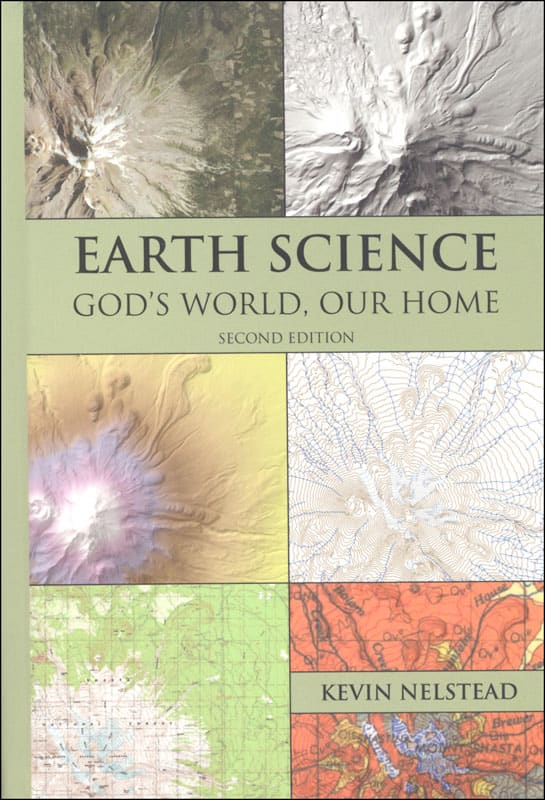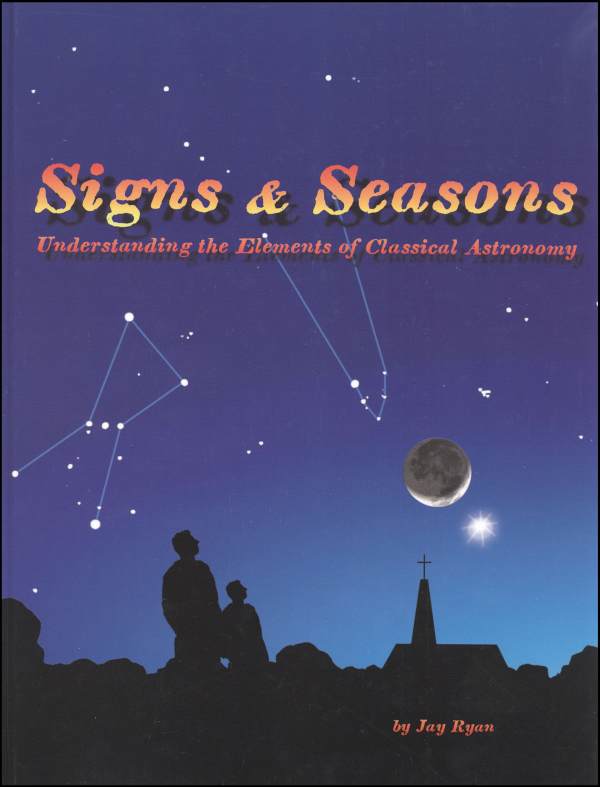Journey Homeschool Academy offers online science courses for Christian students at three levels: A (elementary), B (middle school - grades 6-8), and C (high school). This review focuses on two courses for level B: Experience Astronomy B and Earth Science Explored B. Physical Science Explored B is also available, but I haven't reviewed it.
The courses are presented from a Christian worldview and address concerns Christians have, such as those about the age of the earth and the use of astrology. Students can complete most of their work independently, although parents should supervise some of the lab work for Earth Science.
Student Components
Course components for the student are online videos, a Student Guidebook, and a Field Guide for Astronomy or A Student Lab & Activity Guide for Earth Science. Earth Science also requires lab materials. The books are free as PDFs, but you can purchase spiral-bound, printed versions. One or more optional textbooks are recommended for each course, and I recommend using one to get the most out of the courses.
Parent Resources
Parents should download the curriculum guide from the student management page within their own portal. It has vital information about how the course works. The parent portal also has a brief introductory video.
Quizzes and tests are automatically graded, but parents must evaluate student work completed in their Field Guide or Student Lab & Activity Guide. Parents can access and download answer keys for both. And since student work in these guides is not evaluated by the program, the curriculum guide includes pages for recording scores for student work in the Field Guide or Student Lab & Activity Guide. Parents can also access a quiz answer key to help students study for quizzes or address issues students might have regarding the online quiz questions.
The PDF master schedule for each course is a chart showing the lesson numbers, pages to read in the recommended textbook(s), and the Field Guide or lab assignment. Astronomy includes weekly observation assignments to help students learn how to identify constellations, see how the sky changes throughout the year, and observe moon phases. The master schedule is likely to be useful for both parents and students.
Editable lesson plans are also available to help parents plan their student's daily and weekly schedules. Parents can copy a google doc with suggested lesson plans and modify and adapt it for their student.
Lessons
Each course has 35 lessons, and for each lesson, students will watch or complete the following:
- a lecture video (about 25 minutes long)
- a reading assignment
- a quiz
- an experiment video for some lessons
- a hands-on activity or observation assignment
- pages in their Field Guide or Student Lab & Activity Guide
The lecture videos are presented in a lively manner by Luke Gilkerson. The professionally produced videos include many images and video clips, and Gilkerson always concludes by reviewing key points.
Both courses add a preliminary Lesson 0 with two videos that cover study skills and notetaking. These are the same videos for both courses. Both videos can be watched on one or two days, so Lesson 0 doesn't take a week as do the other lessons.
Student Guidebooks primarily consist of notetaking pages with fill-in-the-blank outlines for students to complete as they watch the lecture videos. Some pages have diagrams to label as shown in the videos. Astronomy teaches vocabulary words within the lectures and notes, while Earth Science adds online flashcards.
Most lessons have students either do an experiment or an observation, depending on the course. These are directed by the Field Guide for Astronomy and the Student Lab & Activity Guide for Earth Science.
Every lesson except those for the exams concludes with a multiple-choice quiz that students must pass with 70% or more correct. Students can retake each quiz until they achieve a high enough score. (Study guides are included.)
Students need to complete all lesson components and check them off before they are allowed to move on to the next lesson.
Online exams (either quarterly or at the end of each semester) are scheduled as week-long lessons. Gilkerson provides review videos and study material to help students prepare for the exams.
Experience Astronomy Level B
Experience Astronomy B was designed for students living in the Northern Hemisphere. It will not work for those in the Southern Hemisphere.
The optional textbook Signs and Seasons: Understanding the Elements of Classical Astronomy by Jay Ryan is scheduled into the lessons. This textbook presents a biblical view of astronomy, as does the rest of the course. An alternative reading schedule is available for using The Stargazer’s Guide to the Night Sky, 3rd edition (Master Books).
Students do not need a telescope, binoculars, or lab equipment. They will be making observations with the naked eye and drawing what they see in their Field Guide. Stargazing video tutorials help students with their outdoor observation assignments. Trisha walks students through how to complete the assignments and gives tips for finding constellations using the help of the online planetarium. Both the Field Guide and the five-page PDF Guide to the Constellations also help students with observations. In addition, the Field Guide lists five usepful websites, such as one that tells moonrise and moonset times for an area.
Ideally, students will begin the course in August or September and view the various constellations as they become visible in the night sky. However, timing, location, and other factors might make this impossible. Nineteen assignments are flexible and can be done any time of year, but 13 are not. For those, students should use an online planetarium. The PDF Observation Schedule shows the ideal schedule for direct observations in one column and dates and times to enter if they use a virtual planetarium.
Ideal times of the day for viewing are provided in both the Field Guide and the Master Schedule. Several observations are to be made at 10 p.m. or later, which might be past bedtime, so parents need to be aware of this before beginning the course. The virtual planetarium might be a substitute, but actual observations are a critical element of the course.
Early in the course, Gilkerson has students either create a “red flashlight” or figure out how to use a red flashlight option on a phone. The red light provides light for drawing activities outdoors at night without interfering with the student’s nighttime vision. Students also create a backyard compass so they can be correctly oriented for observations, and this requires only sticks that they put into the ground.
The course includes a midterm and a final exam.
Note that Experience Astronomy C uses these same lessons, plus 12 more that are inserted into the Level B schedule every two or three weeks. Level C students also create an Astronomy Portfolio and do additional research and other activities.
Earth Science Explored Level B
Students can begin Earth Science Explored B at any time of the year. Two optional textbook options are scheduled into the lessons for this course: Novare’s Earth Science: God's World, Our Home or BJU Press’s Earth Science. Chapters or sections to be read are listed in the curriculum guide as well as on a separate Lesson & Lab Schedule PDF. An online document has schedules for two other popular textbooks: Discovering Design with Earth Science (Berean Builders) and Science: Earth and Space ( Abeka), so these can easily be used instead.
Lessons presented by Luke Gilkerson cover topics such as the spheres of the earth, topography, tectonic plate tectonics, rocks, minerals, natural resources, geological history, the ocean, volcanoes, the fossil record, the sun, weather, and the atmosphere.
Three lessons address geological time theories. Gilkerson presents both young-earth and old-earth views since Christians are in both camps. He grants that the two viewpoints conflict with one another, pointing out that the presuppositions of each viewpoint determine how people interpret the same observations and data. He walks through examples of this so students understand why even Christians can arrive at conflicting conclusions. In the lesson on fossils, Gilkerson states that the old-earth viewpoint is the most widely accepted, but he raises some of the major challenges against it that remain unanswered. Students get a chance to advocate for one view or the other since one lab assignment (that takes two lessons to complete) has students choose one of the models for geological time to explore, and then make an oral presentation about it.
Four of the 35 lessons are dedicated to studying for and taking an exam. The other lessons have a lab assignment, although not all have a lab video, and some require research and writing rather than hands-on work. The 144-page Lab & Activity Guide includes instructions, lists of supplies when applicable, questions to answer, space for drawing (e.g., a topographical map), and space for lab notes.
Lab videos presented by Trisha Gilkerson, with assistance from her son Cameron, run about 3 to 15 minutes. Examples of the lab activities are creating a topographic map using potatoes, building a water barometer to measure air pressure, identifying and observing the characteristics of various rocks and minerals, and creating an erosion simulation. Some activities are presented in the video, and some are presented only in the Lab & Activity Guide. Two examples of the research activities are graphing and analyzing tide data for an area and creating a timeline showing the development of plate tectonic theory.
Students need lab supplies. Journey Homeschool Academy has partnered with Cornerstone Educational Supplies to create a kit for this course with all required materials that are not found around the house. It includes specimens of 30 rocks and minerals, hydrochloric acid, modeling clay, a magnifier, two thermometers, and other resources.
Summary
Journey Homeschool Academy courses provide solid coverage of science yet are easy for homeschoolers to use because the teaching is done for you. The courses are well organized and include several means for students to demonstrate their knowledge.












